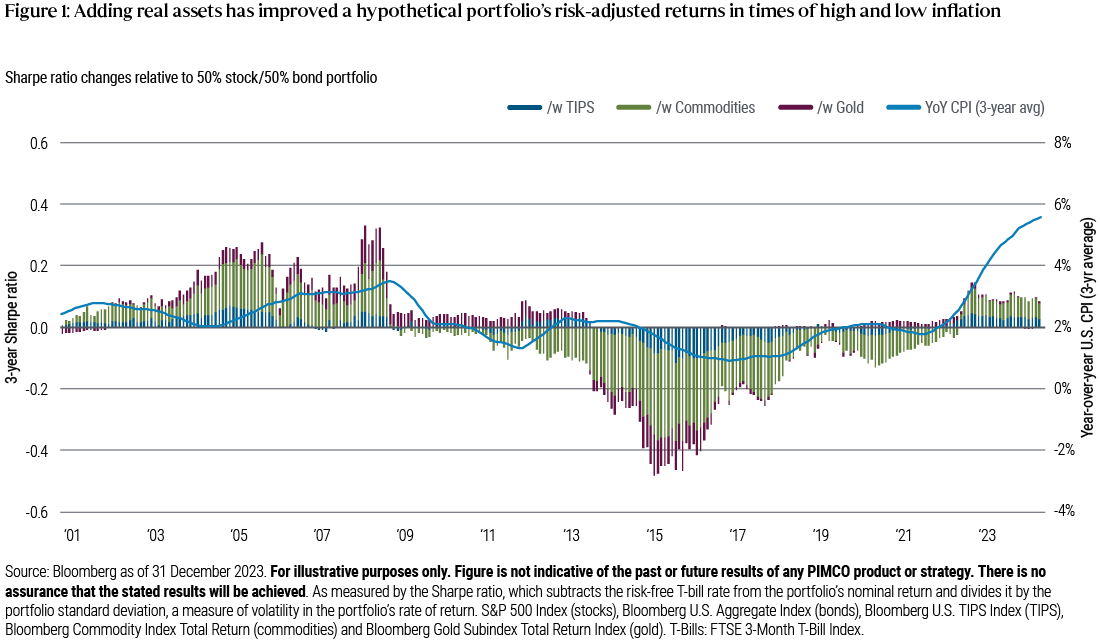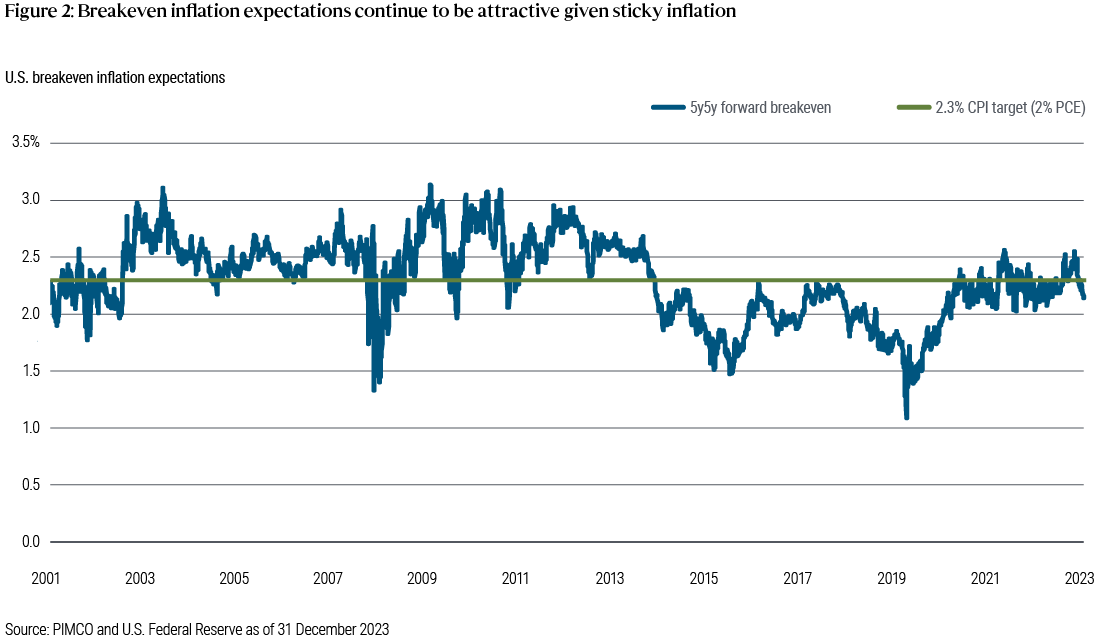Real Assets: Bolstering Portfolios as Inflation Lingers
Developed market central banks have likely reached the end of their rate-hiking cycles, yet a soft landing is far from assured. Looking ahead, two possible alternative scenarios emerge: inflation remains above central bank targets as growth fades into recession, and – potentially more dangerous – inflation rekindles. Amid this uncertainty, we believe it’s critical to design portfolios capable of performing well across a range of inflationary scenarios, which could include an allocation to real assets.
To this end, it is worth examining how adding real assets – which tend to appreciate with inflation – can help improve portfolio resilience. Our analysis starts with a hypothetical 50% stock, 50% bond portfolio and then adds a mix of real assets – Treasury Inflation-Protected Securities or TIPS (10%), broad commodity exposure (5%), and a dedicated gold allocation (2%).Footnote1, Footnote2
We then measure the improvement in inflation-hedging properties based on the increase in portfolios’ inflation betas (defined as the sensitivity of an asset’s return to inflation surprises). The initial stock/bond portfolio has an inflation beta of -2.1, while the new portfolio with real assets has an inflation beta of -1.3, meaning that the negative inflation sensitivity was cut significantly with an allocation to real assets.
Not surprisingly, during the recent inflation surgeFootnote3, the new hypothetical portfolio with real assets outperformed the initial 50/50 portfolio by 62 basis points, with less volatility, over the three-year period that ended 31 December 2023.
Less commonly known, however, is that the benefits of real assets do not require an inflation spike to occur. The inflation-hedged portfolio is generally advantageous even during more mild periods of inflation – when inflation runs at or above the Federal Reserve’s (Fed) 2% target, as we expect it to do this year.
Real assets – a hedge against inflation
Indeed, in the decade leading up to the global financial crisis, it was not uncommon for the consumer price index (CPI) to exceed 2%. During this 10-year period – from 28 February 1998 – the data show on average a 1.20% increase in annualized portfolio returns and a meaningful improvement in risk-adjusted returnsFootnote4 in the portfolio with an allocation to a basket of TIPS, gold, and broad commodities (see Figure 1). Inflation hedging proved valuable as inflation expectations rose, followed by an increase in actual inflation and central bank tightening. During this period, nominal bond and equity prices became positively correlated – declining in unison – while the real assets appreciated, providing valuable diversification.
Will inflation return to pre-COVID lows?
While we expect inflation will decline through 2024, dipping into the 2%-3% range across developed markets (DM), we think it is unlikely to return to the historically low levels of the decade leading into the pandemic, when it ran stubbornly below 2% (for more, see our latest Cyclical Outlook, “Navigating the Descent”). Several forces may apply an upward bias to inflation over the next five years:
First, responding to pandemic-era supply shortages, nations are moving manufacturing closer to home to make supply chains more reliable. The trend of globalization was a dominant factor in the disinflationary environment of the last 25 years; the momentum of its reversal could bring an upward bias to inflation.
Similarly, tensions with China are expected to increase trade frictions and thus the cost of goods consumed in the U.S. Geopolitical hotspots around the globe, including Ukraine, Gaza, and the Red Sea, all carry inflationary risks.
Finally, we think over the coming years DM central banks targeting 2% inflation will be willing to tolerate “2-point-something” percent as part of a strategy in which they expect a shortfall in demand during a future recession to return inflation to target. (For more, see our latest Secular Outlook, “The Aftershock Economy.”)
TIPS appear undervalued
TIPS valuations appear compelling amid generous real yields – a bond’s nominal yield minus the expected rate of inflation – and what we believe are the market’s unrealistically low inflation expectations.
Real yields have climbed to their highest levels since 2009. Following a long period at very low or even negative levels, real yields appear compelling near 2%, particularly as the restrictive policy environment likely gives way to Fed rate cuts in the months ahead. Fed officials have been clear in describing current policy as restrictive, and that a reduction toward a neutral policy stance will eventually be appropriate.
Inflation expectations still reside below DM central bank targets by most measures (see Figure 2). These expectations, reflected in TIPS prices, can be thought of as the hurdle rate for TIPS to outperform nominal bonds. Given the structural risks we see to higher inflation, the market seems to undervalue the U.S. inflation protection these assets can provide a portfolio – both through unforeseen shocks, and during what may well be normal times ahead.
Conclusion
Historical returns underscore the importance of portfolio construction, emphasizing the need for inflation-hedging assets in traditional asset allocations. Our analysis suggested that the hypothetical portfolio’s returns and volatility may still benefit when adjusting the real asset allocations down to 5% and up to 30%. With TIPS near their most attractive valuations in 15 years and commodities still buoyed by geopolitical factors and supply constraints, investors could potentially benefit from an inclusion of real assets.
1 S&P 500 Index (stocks), Bloomberg U.S. Aggregate Index (bonds), Bloomberg U.S. TIPS Index (TIPS), Bloomberg Commodity Index Total Return (commodities) and Bloomberg Gold Subindex Total Return Index (gold). TIPS allocation sourced from bonds, commodities and gold allocations sourced pro-rata from stocks and bonds. Return to content
2 For this hypothetical scenario, we selected 50/50 as the baseline allocation ratio for the stock/bond mix (i.e., 50% S&P 500 and 50% Bloomberg U.S. Aggregate Index). For illustrative purposes, this 50/50 selection balances between the 60/40 stock/bond ratio typical in many U.S. portfolios and the 40/60 ratio common in Europe.
The allocation chosen is hypothetical, but the analysis was tested across a range of weights for real assets. The analysis suggested that portfolio return and volatility may benefit when real asset allocations ranging between 5% to 30% were added to the original 50/50 stock/bond portfolio (sourced as described in footnote 1). Return to content
3 As calculated from 31 December 2020 through 31 December 2023. Return to content
4 As measured by the Sharpe ratio, which subtracts the risk-free T-bill rate from the portfolio’s nominal return and divides it by the portfolio standard deviation, a measure of volatility in the portfolio’s rate of return. For the purposes of this blog we used the FTSE 3-Month T-Bill Index. Return to content↩
Featured Participants
Disclosures
Past performance is not a guarantee or a reliable indicator of future results.
Equities may decline in value due to both real and perceived general market, economic and industry conditions. Investing in the bond market is subject to risks, including market, interest rate, issuer, credit, inflation risk, and liquidity risk. The value of most bonds and bond strategies are impacted by changes in interest rates. Bonds and bond strategies with longer durations tend to be more sensitive and volatile than those with shorter durations; bond prices generally fall as interest rates rise, and low interest rate environments increase this risk. Reductions in bond counterparty capacity may contribute to decreased market liquidity and increased price volatility. Bond investments may be worth more or less than the original cost when redeemed. Inflation-linked bonds (ILBs) issued by a government are fixed income securities whose principal value is periodically adjusted according to the rate of inflation; ILBs decline in value when real interest rates rise. Treasury Inflation-Protected Securities (TIPS) are ILBs issued by the U.S. government. Commodities contain heightened risk, including market, political, regulatory and natural conditions, and may not be appropriate for all investors.
Statements concerning financial market trends or portfolio strategies are based on current market conditions, which will fluctuate. There is no guarantee that these investment strategies will work under all market conditions or are appropriate for all investors and each investor should evaluate their ability to invest for the long term, especially during periods of downturn in the market. Investors should consult their investment professional prior to making an investment decision. Outlook and strategies are subject to change without notice.
Hypothetical illustrations have many inherent limitations, some of which are described below. No representation is being made that any account will or is likely to achieve results similar to those shown. In fact there are frequently sharp differences between hypothetical results and actual results subsequently achieved by any particular trading program.
One of the limitations of hypothetical results is that they are generally prepared with the benefit of hindsight. In additional, hypothetical scenarios do not involve financial risk, and no hypothetical illustration can completely account for the impact of financial risk in actual trading. For example, the ability to withstand losses or to adhere to a particular trading program in spite of trading losses are material points which can also adversely affect actual trading results. There are numerous other factors related to the markets in general or to the implementation if any specific trading program which cannot be fully accounted for in the preparation of a hypothetical illustration and all of which can adversely affect actual results.
Inflation Beta is used to measure an asset’s ability to hedge inflation. It measures the change in inflation versus the return of the asset over a specific period. For example, an inflation beta of 3 indicates that the asset’s return would go up by 3% for a 1% rise in inflation. The Sharpe Ratio measures the risk-adjusted performance. The risk-free rate is subtracted from the rate of return for a portfolio and the result is divided by the standard deviation of the portfolio returns.
S&P 500 Index is an unmanaged market index generally considered representative of the stock market as a whole. The Index focuses on the large-cap segment of the U.S. equities market. Bloomberg U.S. Aggregate Index represents securities that are SEC-registered, taxable, and dollar denominated. The index covers the U.S. investment grade fixed rate bond market, with index components for government and corporate securities, mortgage pass-through securities, and asset-backed securities. These major sectors are subdivided into more specific indices that are calculated and reported on a regular basis. Bloomberg U.S. TIPS Index is an unmanaged market index comprised of all U.S. Treasury Inflation-Protected Securities rated investment grade (Baa3 or better), have at least one year to final maturity, and at least $500 million par amount outstanding. Bloomberg Commodity Index Total Return is an unmanaged index composed of futures contracts on a number of physical commodities. The index is designed to be a highly liquid and diversified benchmark for commodities as an asset class. The futures exposures of the benchmark are collateralized by US T-bills. Bloomberg Gold Subindex Total Return Index reflects the return on fully collateralized positions in the underlying commodity futures. It is not possible to invest directly in an unmanaged index.
PIMCO as a general matter provides services to qualified institutions, financial intermediaries and institutional investors. Individual investors should contact their own financial professional to determine the most appropriate investment options for their financial situation. This material contains the opinions of the manager and such opinions are subject to change without notice. This material has been distributed for informational purposes only and should not be considered as investment advice or a recommendation of any particular security, strategy or investment product. Information contained herein has been obtained from sources believed to be reliable, but not guaranteed. No part of this material may be reproduced in any form, or referred to in any other publication, without express written permission. PIMCO is a trademark of Allianz Asset Management of America LLC in the United States and throughout the world. ©2024, PIMCO.
CMR2024-0129-3358900


